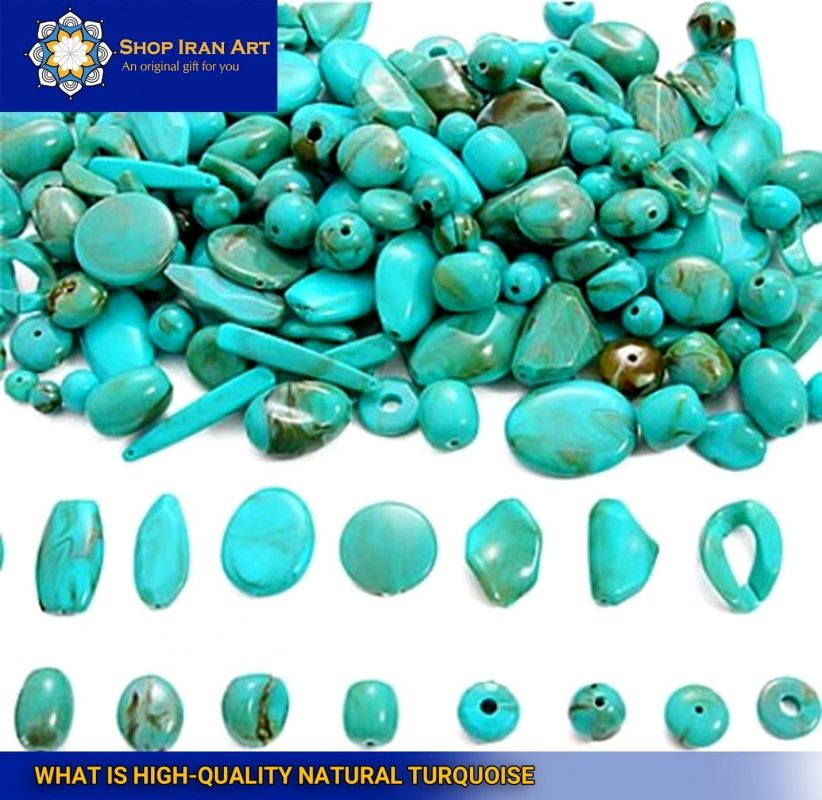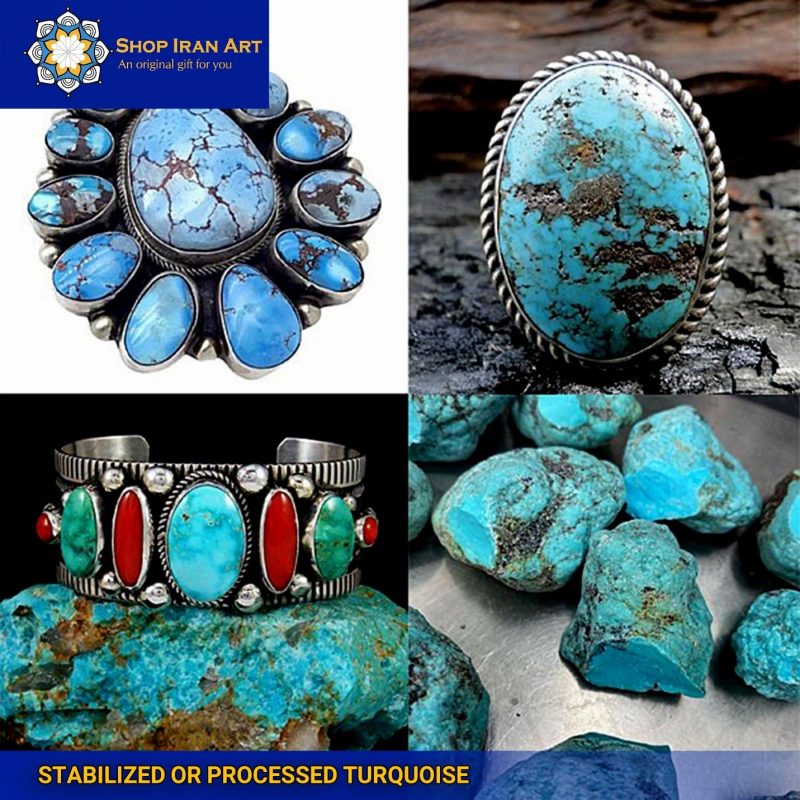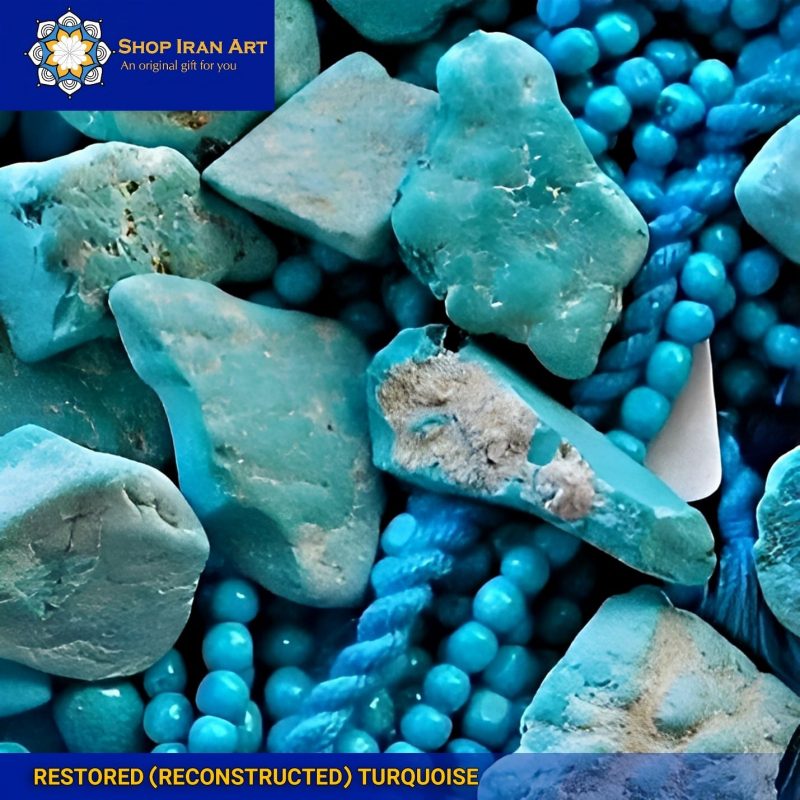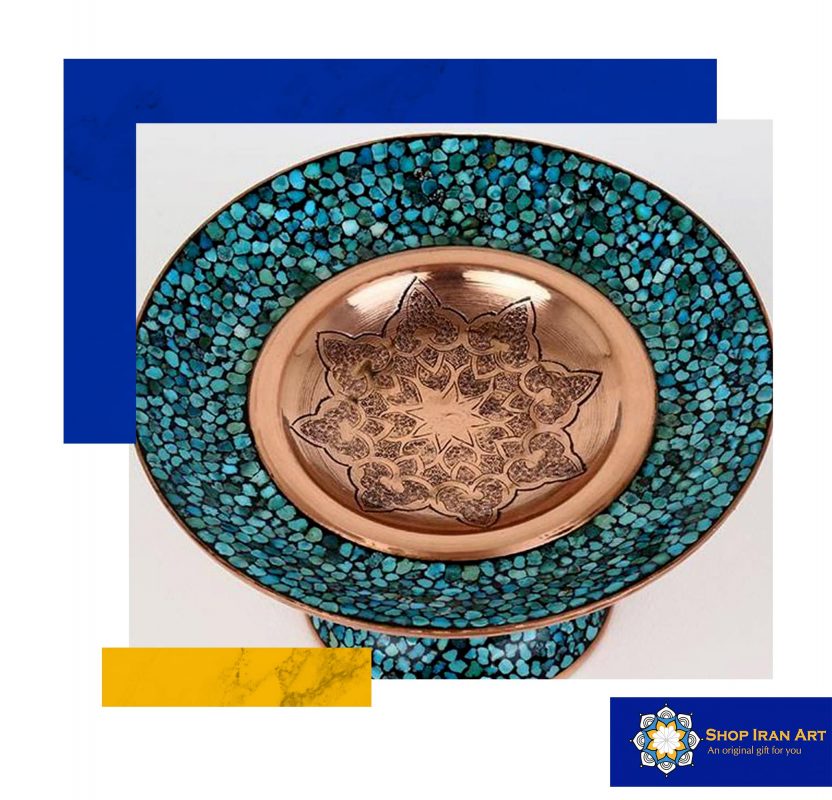Sin categorizar
What Is The Best Type Of Turquoise?
VARIETIES OF TURQUOISE AND ITS PROCESSING
Learn to select high-quality turquoise and distinguish between varieties. The highest quality turquoises are available on this site; shopiranart.com
Turquoise is an opaque, blue-to-green mineral that is a hydrous phosphate of copper and aluminum
What is high-quality natural turquoise?
The quality of turquoise is determined by the hardness, brilliance, and color of the stone. The first question you should ask is if it is natural turquoise – pay attention to the unique characteristics of turquoise – color/matrix and place of production.

High-quality natural turquoise is found in all shades, from sky blue to apple green. It is the hardest of the turquoise grades and is accordingly the best polished. The contrast between the color of the turquoise and the color of the matrix (or parent rock) enhances the beauty of each stone. But the matrix may be absent if the size of the stone is not large. High-quality natural turquoise is rated AA, AAA, and AAAA (which is practically unavailable for purchase and makes up less than 1% of all turquoise on the market and in mines). The cost of such stones reaches hundreds of thousands of dollars. These top three grades of turquoise are typically in the 5-6 range on the Mohs scale of gemstone hardness.
Natural turquoise (not the highest grade, but standard gem quality) :
Conventionally standard natural turquoise is what most mid to high-end jewelers use. These mineral specimens are rated AA-, A, B, and C. These grades of natural, untreated turquoise are determined primarily by hardness, matrix pattern, and color. Gem-quality natural stones have medium to low saturation and color purity, a noticeable decorative matrix, and color from deep blue and turquoise to turquoise with a grayish tint. These turquoise grades are typically in the hardness range of 4-5 on the Mohs scale. Such turquoise makes up about 20-30% of the production of most turquoise mines, which is also not much for the world market.
Low-grade natural turquoise:
These are the lowest grades of turquoise and usually turn into stabilized or refined turquoise. Low-grade turquoise is usually very soft 3-4 on the Mohs scale, brittle, and pale in color. Low grades of turquoise also include not very attractive shades of turquoise/matrix-dominated stones. Low grades of turquoise are graded C, D, and Chalk Turquoise (these are porous or calcareous (chalk) chalky examples of natural turquoise). This is turquoise that should not be used in jewelry without processing. It is characterized by microporosity, which increases just as its hardness decreases. To a large extent, such a breed is subject to the actions of various household substances – perfumes, oils, fats, and chemical compounds, especially organic ones (gasoline, acetone). Accordingly, it is this turquoise material,
Turquoise has withstood the vicissitudes of fashion as well as the passage of millennia.
ENNOBLED TURQUOISE:
The most common treatment for turquoise is impregnation with organic materials, but synthetic inorganic polymers can also be used in combination with dyes to enhance the color. There is also one patented way to improve the properties of natural turquoise, called “Zaheri”.
The details of the process are rather cryptic as the company is trying to preserve its knowledge of the invention. It is known to involve impregnating certain chemicals with medium or higher-quality stones, followed by process of heating under pressure to stabilize the stones. This makes the stone harder, darkens the color, and after the stone is well polished.
Refurbished (pressed)
When processing natural stones, a kind of waste often remains. This is a small crumb or even dust that occurs during the refinement of a natural gem. It is this place that becomes the material for creating a pressed mineral. It is collected, mixed with special compounds, pressed, and processed. Also, low-quality turquoise, which is unsuitable for cutting or has very small sizes, can be used for this. They are also ground into powder, mixed with additives, and pressed, and whole pieces of the mineral are obtained.
Pressed stone is most often found on the shelves of jewelry stores. But even such specimens cannot be called artificial or fake. This is the same natural turquoise, which was simply improved in terms of performance and appearance.
STABILIZED OR PROCESSED TURQUOISE:
A process in which pressure and heat are used to fill microscopic cracks in the stone with polymers, resin, or glass. As a result, soft and porous turquoise samples become harder, which allows them to be cut and faceted, as well as protects them from further changes. With high-quality processing, stabilized turquoise is visually indistinguishable from high-grade natural samples. It is the stabilization that allows lower-quality real turquoise to be used in turquoise jewelry. The stabilization process does not include coloring and changing the external decorative properties of the rock.

WAXED TURQUOISE:
In ancient times, turquoise was covered with wax to make it more glossy. Paraffin treatment deepens and stabilizes the color, though only on the surface. Many Tibetan and Egyptian turquoise beads are still processed in such a way that it is possible not to polish the stone while maintaining its original weight and natural shape.
RESTORED (RECONSTRUCTED) TURQUOISE:
The term describes crushed crumbs and turquoise dust mixed with blue and green dye and bound with plastic or cement. Most products sold under this name should be sold as imitation turquoise, as such material is no longer natural stone. From larger pieces of a similar product, imitations of nuggets are also created.

turquoise is a hydrated copper/aluminum phosphate of aggregate, cryptocrystalline structure.
Understanding Turquoise
Turquoise is a hydrous phosphate mineral with a put to the family of copper-aluminum phosphates. Its title derives from the French word “Pierre turquoise,” meaning “Turkish stone.” This gemstone is molded through a complex get ready counting the penetration of water-carrying minerals and metals through shake courses of action. Over time, the minerals and metals react with copper, coming almost inside the shape of turquoise.
Persian Turquoise
Persian turquoise, known as Iranian turquoise, is considered one of the world’s finest and most helpful. It is exceedingly regarded for its blue color, regularly with complicated web-like plans known as “spiderwebbing.” Persian turquoise is respected for its chronicled significance and is known to have been utilized in outdated jewels and enhancing objects.
Sleeping Beauty Turquoise
Named after the Sleeping Beauty Mine in Arizona, this turquoise is renowned for its pure sky-blue color. Jewelry designers highly seek it for its consistent color and minimal matrix (the host rock within which the turquoise forms). Sleeping Beauty turquoise is treasured for its clean and vibrant appearance, making it a popular choice for contemporary jewelry designs.
Kingman Turquoise
Kingman turquoise, sourced from the Kingman Mine in Arizona, is celebrated for its striking blue color and engaging system plans. It is known for its incredible hardness and durability, making it sensible for diverse diamond applications. Kingman turquoise can expand from light blue to significant green blue, routinely appearing as a superb spiderweb framework.
Chinese Turquoise
China has been a noteworthy maker of turquoise for centuries, with a rich history of mining and making this wonderful gemstone. Chinese turquoise is known for its assorted colors and qualities, with varieties incorporating blue, green, and yellow tints. This difference is due to China producing turquoise from a few distinctive locales, each claiming attractive geographical cosmetics and mineral stores.
Bisbee Turquoise
Bisbee turquoise hails from the Bisbee mine in Arizona, which is no longer in operation. Collectors and jewelry enthusiasts highly covet it for its rich blue color, intricate matrix patterns, and rarity. Bisbee turquoise is considered a collector’s gem due to its limited availability, making it highly valued in the market.
Royston Turquoise
Royston turquoise in Nevada is recognized for its vibrant green-blue color and distinctive matrix patterns. It is known for its varied colors and unique veining, making each piece of Royston turquoise genuinely one-of-a-kind. The captivating combination of colors and patterns makes Royston turquoise a favorite among jewelry designers.

Morenci Turquoise
Morenci turquoise may be an exceedingly esteemed sort that begins from the Morenci mine in southeastern Arizona. This staggering gemstone is known for its rich blue color, frequently blended with striking pyrite veins. The pyrite considerations donate Morenci turquoise a unique metallic luster that includes its by and considerable excellence and appealing quality.
Nevada Blue Turquoise
As the name suggests, Nevada Blue turquoise comes from Nevada and is treasured for its vibrant blue hue. It is known for its solid, consistent color and minimal matrix. Nevada Blue turquoise is often used in jewelry designs requiring a bold, eye-catching centerpiece.
Cerrillos Turquoise
Cerrillos turquoise, mined in New Mexico, is esteemed for its various colors, including blue, green, and brown. It possesses a unique charm with its earthy tones and distinct matrix patterns. Cerrillos turquoise has a long history of use by Native American tribes in traditional jewelry and artwork.
How to Choose the Best Turquoise
A few variables should be considered when selecting turquoises, such as color, lattice designs, hardness, and individual inclinations. Choosing a turquoise that reverberates with your fashion and tasteful tendencies is fundamental. Furthermore, considering the planning utilization of the turquoise, whether for adornments or enriching purposes, can direct your choice.

Turquoise Grades and Quality Factors
Turquoise is reviewed based on color, hardness, network designs, and general aesthetics. Whereas there’s no standardized reviewing framework for turquoise, assessing these components can assist in deciding a gemstone’s quality. The reviewing preparation includes evaluating the stone’s color concentrated, the nearness of the framework, and any flaws which will influence its esteem.
Shop Iran Art offers a diverse selection of exquisite artworks that showcase Iran’s rich cultural heritage and artistic traditions. With its carefully curated collection, art enthusiasts can explore and acquire unique pieces that reflect the beauty and craftsmanship of Persian art.
What colors are turquoise
The color largely depends on the deposit. Contrary to popular belief that natural turquoise has a bright blue tint, it is worth noting that this is not the only color that the mineral can be dyed. There are also gems of white, green, brown, yellow, and even brown shades.
The most common stone color is, of course, blue or simply turquoise. In addition, the characteristic stripes on turquoise can also differ in saturation and color. Indeed, in addition to black stripes on the stone, one can also distinguish green, blue, brown, and white layering.
FAKE COLORED STONES:
There are a few natural stones that look like turquoise when they are colored turquoise – these include howlite and magnesite. Recently widespread imitations of turquoise are “composites”, which are based on carbonates (magnesite, dolomite, calcite), ground into powder, and glued together with plastic or epoxy resin. The color of these minerals is white, so they are used after staining. Other imitations include glass, plastic, earthenware and polymer clay. They will have different specific gravity, hardness, nature of inclusions and pattern. You should be alerted by the low price, even the same color.
How to Choose the Best Turquoise
A few variables should be considered when selecting turquoises, such as color, lattice designs, hardness, and individual inclinations. Choosing a turquoise that reverberates with your fashion and tasteful tendencies is fundamental. Furthermore, considering the planning utilization of the turquoise, whether for adornments or enriching purposes, can direct your choice.
Turquoise Grades and Quality Factors
Turquoise is reviewed based on color, hardness, network designs, and general aesthetics. Whereas there’s no standardized reviewing framework for turquoise, assessing these components can assist in deciding a gemstone’s quality. The reviewing preparation includes evaluating the stone’s color concentrated, the nearness of the framework, and any flaws which will influence its esteem.
Shop Iran Art offers a diverse selection of exquisite artworks that showcase Iran’s rich cultural heritage and artistic traditions. With its carefully curated collection, art enthusiasts can explore and acquire unique pieces that reflect the beauty and craftsmanship of Persian art.
What turquoise is valued?
What is the most valuable turquoise?
Blue turquoise (young) - bluish, bluish, sometimes slightly greenish, dense, the most valuable
What color is natural turquoise?
Blue, light blue, greenish blue (which is called turquoise), often with brown spots




